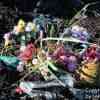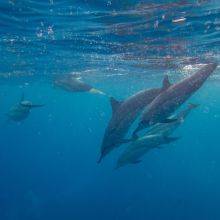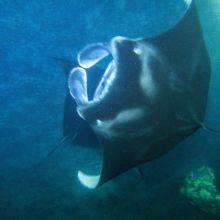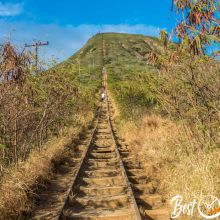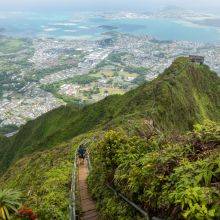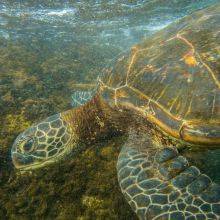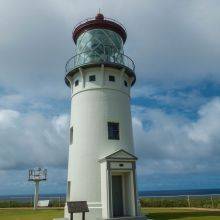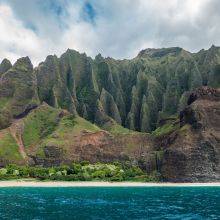When Is the Best Time
The Big Island is best visited in the spring or the fall: It's less busy than in peak season, and the weather is pleasant. Alerts due to seismic activity and monthly updates - scroll down for more information about the partially reopening and what remain closed.
Weather Overview
Hawaii is a sunny and warm paradise with very little temperature variation throughout the seasons. Check out the Big Island Weather Guide. There is even less rain in the drier season from May until October. However, it's a tropical climate, and some rain can always occur in Hawaii. That's the reason why the islands have lush and green vegetation. The north and east coast get more rain than south and west which is the leeward side. Although the temperatures are pleasant year-round, bring a light jacket or sweater for hiking tours in the park. Because it can be a little cooler at the higher elevations, you'll cross while hiking.
Update May 23 2021
Currently, there is poor air quality at Kilauea due to unhealthy levels of gas emission. For people with respiratory diseases like asthma, it is not advisable to visit the park at the moment.
Low Season and High Season
Fewer visitors in spring and fall: April to early June and September (after Labor Day) to OCTOBER. However, it's busier during the "Golden Week" in Japan at the end of April until the beginning of May. It also gets very crowded when the Ironman takes place in October. Busy and increasing rates in summer (mid-June through August), during Christmas, New Year's Eve (mid-December until mid-January) and on Independence Day. Months with the highest visitation in general: Mid-June until August and December as well as January.
Avoiding the Crowds
Especially the top spots can get very crowded during the daytime, not only in peak seasons. Our top tips to dodge the crowds:
Jaggar Museum / Crater Overlook remain closed for years
Almost everyone wants to see the eruptions of the glowing lava lake in the dark/dusk and visit the museum at the same time. That’s why this place gets ridiculously crowded between 5:30 PM and 7:30 PM. What to do? Split your visit: The museum is open from 10:00 AM - 07:30 PM. Be there first thing in the morning. Then visit the overlook (accessible 24/7) separately in the late evening, after the crowds are gone. You may also visit even later around midnight or early in the morning between 5:00 and 6:00 AM: It’s the most fascinating time to watch the breathtaking glowing lava in the dark, in magical solitude.
Thurston Lava Tube (Nāhuku):
Starts to get crowded around 10:00 AM. Be there much earlier in the morning. Not only parking space is easily available, but the tube is almost empty of visitors when you get there early.
Kīlauea Iki Trail: remain closed for years
It is truly stunning and scenic but also the most popular trail. Start this 2-hour hike (4 miles) at least between 8:00 and 8:30 AM to avoid sharing the trail with too many others. This is also a good idea in summer before it gets too hot and humid.
Mauna Loa Road and trail are reopened
Hiking Without the Crowds
There are many other underrated and less crowded, yet not less fascinating trails. Check out these Underrated Hiking Trails. Visit the official NPS Visiting Tips for additional information.
Alerts (Seismic Activity)/ Reopening in 2018
These activities occurred in 2018. I leave them in my article to give you an idea that this is an active volcano. Eruptions can occur and cause damage.
May 2018: Hawai‘i Volcanoes National Park is closed due to the possibility of explosive steam and ashfall at the summit of Kīlauea Volcano.
June 2018: There are still frequently steam explosions and ash fallouts at Kilauea Crater at the end of June. The ash has an impact on most of the island. Earthquakes occurred measuring a magnitude up to 5.6.
July 2018: Increasing activity at Halemaumau Crater equally to an earthquake with 5.3 magnitudes. If possible avoid the area around the National Park and the HW 11at the 30-mile marker near Volcano due to road damage.
August 2018: Seismic activity can still happen at any time. More than 60 eruptions occurred from May to August.
September 2018: On September 22nd parts of the park may be reopened. Anyhow, Kilauea and Mauna Loa Summit remain closed for safety reasons. HW 11 is open despite damages between mile marker 28 to 32.
Late October 2018: Most of the park got reopened, but eruptions and earthquakes can happen again. Don't leave the marked trails. Stay on the roads for your own safety.
- More information about the reopening and Maps of Halemaumau Crater and the National Park
- More details: NPS News Release and Video
- Regular Updates: Check the NPS Facebook Page
Best Months to Visit
Location and Tips

Volcanoes National Park is one of the most popular attractions in Hawaii. One of the must-do things is to view the glow of the lava flow into the ocean at sunset, which is also offered by boat.
The National Park is already more than 100 years old, declared in 1916. It is a World Heritage Site since 1987. The National Park offers a dramatic volcanic landscape with the biggest volcanoes, the Mauna Kea and the Mauna Loa. You can drive almost to the summit of the world’s most massive active volcano, the Mauna Loa 4.169 m high. The view from the top is spectacular. Even when it is foggy at sea level, you may have a beautiful view from Mauna Loa to the other islands. The Mauna Kea is 4207 m high above sea level and measured from the bottom of the sea almost 10.000 meters high, the highest mountain on earth. Mauna Loa is the second highest and Mount Everest, by comparison, is the third highest mountain. Additionally, visit the summit of Mauna Kea during sunset.
Besides the lava viewing at the crater at Jaggar Museum, it’s highly recommended to experience the lava at the flow: Into the ocean from the volcano Pu'u O'o the hike takes between half an hour and an hour. Either take a guided hike and you come close to it or hike self-guided. The direction of the flow is always changing. Check the description from the Love Big Island Article and the latest information about the flow: NPS Flow Update
Useful Links and Resources
- Visitor Centers and opening hours: NPS Hawaii Volcanoes Visitor Centers
- Maps of the park: Official NPS Map
- List and description of day hikes: NPS Day Hikes
Some of the pictures are provided by my friend and diver Leif








